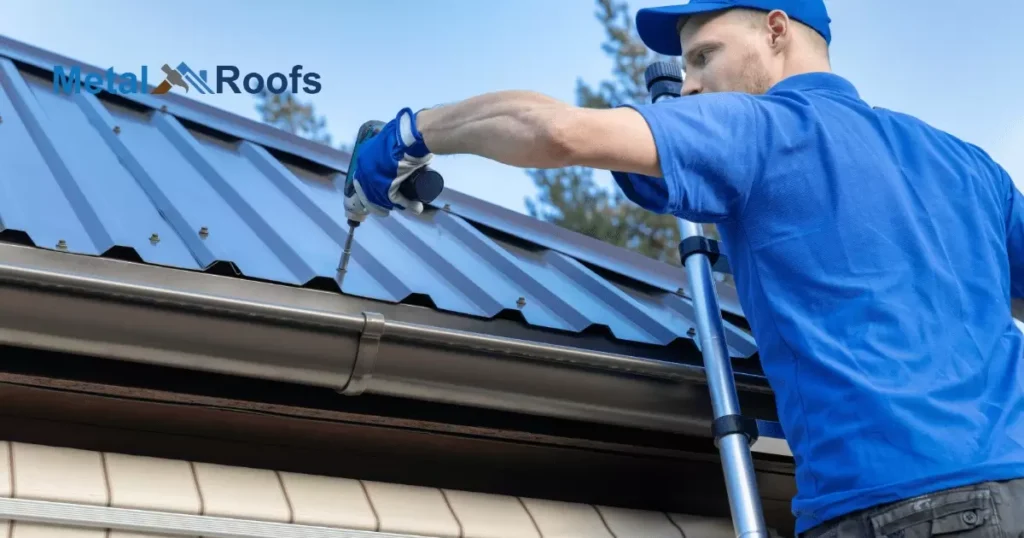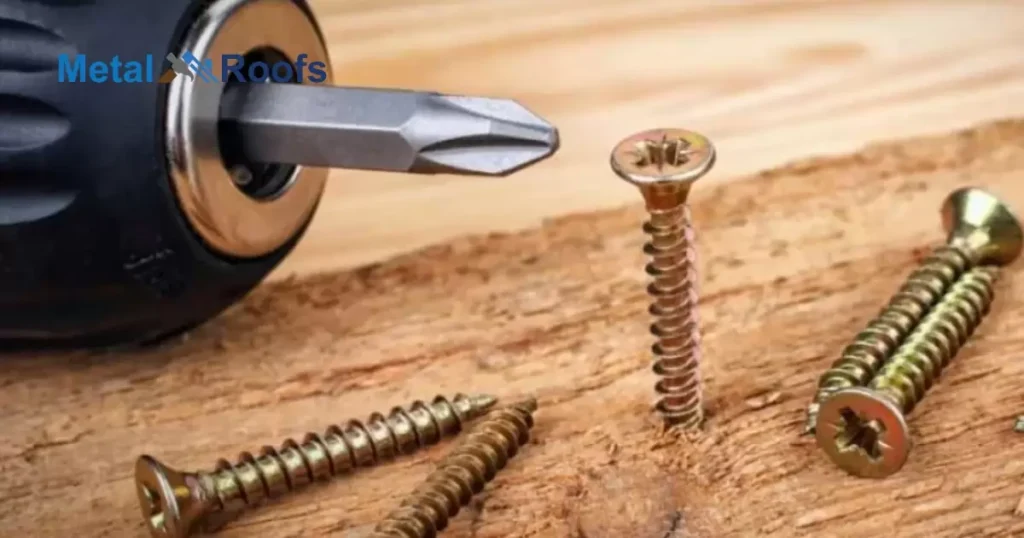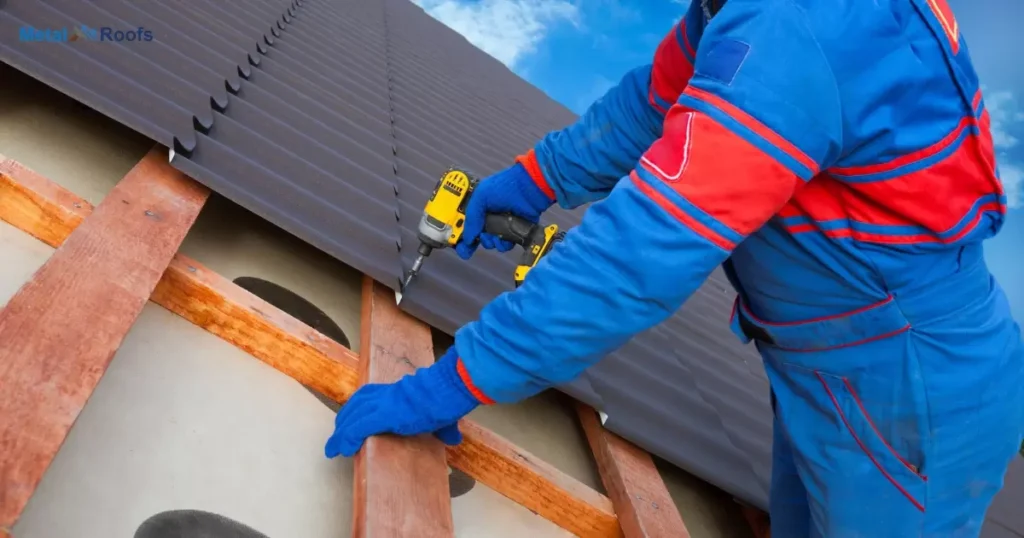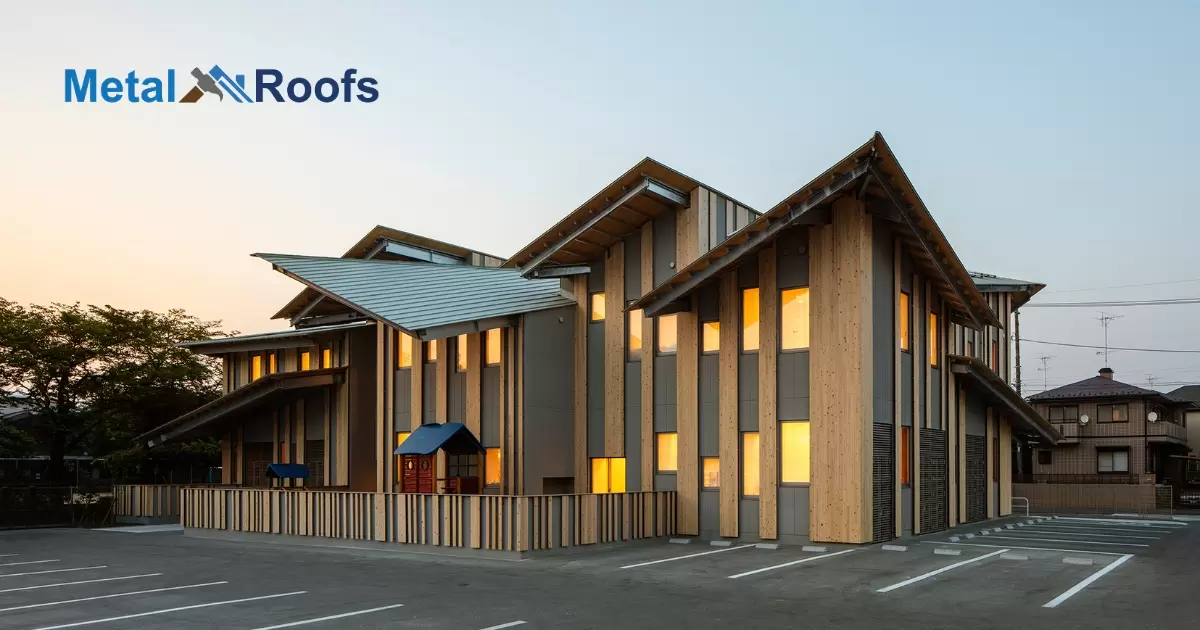Screws on a metal roof secure roofing panels and flashings through predrilled holes to the roof deck below. The screws create a weather tight seal against rain and wind when installed properly with appropriate washers.
Screws hold down roof panels. Where to put screws on a metal roof ? Srews at the overlap of roof panels create a tight seal. Screws go along the length of roof panel ribs. Proper screw placement prevents leaks. It resists wind lift. Correct screw installation is key.
Ensure reliable garage roof repair by following manufacturer guidelines for screw placement typically one per rib. Secure panel endlaps and overlaps, applying proper torque to prevent stripped threads. Opt for quality, rust-resistant screws to enhance durability and prevent leaks.
Key Takeaway
- Space per manufacturer guidelines, typically one screw per rib.
- Screw along endlap seams and panel overlaps.
- Use washers to seal holes.
- Tighten screws to specified torque.
- Use quality corrosion resistant screws.
- Check for leaks after installing.
- Correct improperly placed screws.
Importance Of Proper Placement Of Screws On A Metal Roof
| Aspect | Importance |
|---|---|
| Weather Resistance | Proper screw placement ensures a secure roof in all weather conditions. |
| Structural Integrity | Correct placement enhances the roof’s overall strength and stability. |
| Leak Prevention | Ensures a tight seal, reducing the risk of water leaks and damage. |
| Longevity | Properly positioned screws contribute to the roof’s durability over time. |
| Energy Efficiency | Helps maintain insulation integrity, optimizing energy efficiency. |
| Aesthetic Appeal | Correctly placed screws maintain the roof’s visual appeal and uniformity. |
Proper screw placement is key for a sturdy metal roof. Put screws on the raised parts of panels, not the flat spaces. This keeps water out and boosts the roof’s strength. Secure screws into support structures, called purlins, under the roof. Don’t forget edges screws here resist wind. The middle, follow the maker’s pattern for support and wind resistance.
Ridge and hip areas need screws too. Always use the recommended screws and spacing from the manufacturer. Local weather matters adjust screw placement for wind or snow. Adhering to guidelines ensures a robust, weather-resistant metal roof.
Types Of Metal Roofing Screws
Metal roofing screws are essential components in the installation of metal roofs, providing a secure and weather-resistant fastening system. There are several types of metal roofing screws designed for different purposes and conditions.
Overview Of Different Types Of Metal Roofing Screws
Metal roof screws go where the panels overlap or along raised seams, avoiding flat spots. Secure them into the purlins, especially at the edges to resist wind. The manufacturer’s guide for a strong field pattern, avoiding stress. Ridge and hip areas also need screws.
Comparison Of Economy Screws And Long Life Screws
Economy screws are budget-friendly but may rust. Long life screws cost more, resist rust, and last longer. Both work for panel overlap, but long life screws excel at edges and critical areas. Follow the roof manual for correct placement.
Advantages And Disadvantages Of Each Type
Metal roofs last long, resist fire, and handle severe weather, but they can be noisy during rain and prone to denting. Proper screw placement ensures stability and prevents leaks. Each roofing type has pros and cons, so following guidelines is crucial for success.
Factors To Consider When Placing Screws On A Metal Roof
When putting screws on a metal roof, focus on the overlap of panels. Put screws on the raised ribs, not the flat areas, preventing water issues. Secure screws into the purlins or support structure below. Edge areas need screws for stability against wind. In the field, follow the manufacturer’s guide for spacing.
Ridge and hip areas also require screws for proper installation. Always use the recommended fastening system and avoid placing screws too close to each other to prevent metal stress. Consider local weather when deciding on screw placement. The best results, stick to the guidelines from the manufacturer and local building codes.
Pitch Of The Roof

The pitch of your roof matters. It’s the angle of the slope. When dealing with a metal roof, screws go where the panels overlap. They grip onto the ribs, not the flat spots. It’s about stability and keeping water out.
Remember the purlins underneath? That’s where screws dig in. Eaves and gable ends get some too. Wind won’t lift the edges if you secure them right. Follow what the manufacturer says about the screws the type, size, and spacing. Check local codes too. Keep it sturdy and weatherproof. That’s how you pitch it right.
Wind Uplift Resistance Requirements
When putting screws on a metal roof, focus on the panel overlaps and put them on the raised ribs for stability. Secure screws along the edges, especially near the eaves and gable ends, to resist wind uplift. Make sure to fasten the screws into the support structure or purlins underneath.
The manufacturer’s guidelines for the right screw types, sizes, and spacing. Avoid putting screws too close to each other to prevent metal stress. Also, consider the local weather extra screws may be needed in windy or snowy areas. Following these steps ensures a solid metal roof that can handle whatever weather comes its way.
Building Code Requirements
When putting up a metal roof, follow the building code rules. Screw placement matters. Stick screws on the panel overlaps and along the edges. Secure them in the purlins beneath. No screws in the flat spots between ribs, or water might sneak in.
Each metal type may need a different screw pattern. Manufacturers give specs. Don’t crowd screws give them space. Check local codes, too. Wind and snow decide screw needs. Be wise get a pro if unsure.
Practices for Placing Screws on a Metal Roof
Place screws on metal panel overlaps and ribs, avoiding flat areas. Secure screws into support structures like purlins. Along edges, secure screws at eaves and gables. In the field, follow the manufacturer’s plan, avoiding bunching for stress. Adapt for weather and follow local codes or get a pro for peace.
Recommended Spacing Between Screws
Space screws on the raised parts, not the flat bits, to keep water out. Also, attach screws on the edges to stop wind lift. The manual for the right screws and spacing for a secure metal roof.
Recommended Distance From The Edge Of The Panel
Secure the metal panel edges with screws at the eaves and gable ends, following manufacturer guidelines. Maintain the right distance between screws to prevent stress concentration and ensure stability. Adhere to recommended spacing for a durable roof that meets local building codes.
Recommended Screw Length
Pick the right screw length for your metal roof. Go for screws long enough to grip the support structure. The manufacturer’s advice for stability and durability. Using short screws risks leaks and compromises the roof. Stick to the recommended length for security and weather resistance.
Recommended Screw Type For Different Types Of Metal Roofing Material
Choose screws wisely for metal roofs. In panel ribs for raised seams, on purlins below, and along edges. Guidelines for metal type and weather conditions to ensure a strong, durable roof.
Screws For Metal Roof To Wood

When attaching a metal roof to wood, place screws on the panel ribs for stability. The raised sections, or seams, are key. Secure the screws into the wood support structure, usually purlins. Don’t screw into the flat areas between the ribs to avoid leaks. Along edges and eaves, add screws to prevent wind issues.
Follow the manufacturer’s guide for screw types and spacing. Mind weather conditions adjust screw quantity for wind or snow. Optimal installation, stick to the guidelines and consider professional help if needed.
Should You Replace Screws In Metal Roof
Proper screw placement on a metal roof is crucial. Secure screws in panel overlaps, on purlins, and along edges to prevent wind uplift. The manufacturer’s pattern in the field area and secure critical points like ridges and hips.
The recommended fastening system for best results. Adhering to these guidelines ensures a sturdy and weather resistant metal roof. When in doubt, consult with a professional roofing contractor for reliable installation.
Where To Screw In Metal Roofing?
To screw in metal roofing, start by placing screws on the low points of the panels. These are the valleys between the raised ridges. This placement helps avoid leaks and supports the roof better. Put the screws every 12 to 24 inches along the seams.
Make sure you use screws made for metal roofing. These screws come with a rubber washer to seal the holes. Do not over-tighten the screws as it can damage the panels. Check your local codes for any specific requirements.
Where Do You Put Screws In Metal Roofing?

When installing screws on a metal roof, use screws made for metal roofing. They have rubber washers to prevent leaks. Place screws in the valleys or flutes of the panels. This is where the panels are supported and avoids puncturing the ridges.
Screw along the ridges but not on the very edge of the panel. Follow spacing recommendations, usually every 12 to 24 inches along the seams. Tighten screws until the rubber washer is compressed but not deformed. Check local building codes for specific installation requirements.
Frequently Asked Questions
How Far Apart Are Screw Lines For Metal Roof?
A metal roof, place screws in panel overlaps and edges. Avoid flat areas between ribs. Spacing guidelines, secure screws in purlins, and use recommended systems at ridge and hip areas.
Where Can I Drill A Metal Roof?
Drill on the raised parts, like ribs or seams, for stability. Secure screws into the purlins underneath for a strong foundation.
Can You Screw Metal Roofing Directly On Rafters?
Screw metal roofing on ribs, not flat areas. Purlins for support. Edge and field screws secure panels. Follow guidelines and consider weather for a sturdy roof.
Conclusion
Proper screw placement is vital. It ensures roof integrity against wind and rain. The roofing manufacturer’s guide. Space screws as recommended along panels. Seal all holes with washers. Tighten screws to specified torque. Use quality corrosion-resistant screws. Check for leaks after installation. Correct any improperly placed screws.
Installing screws on metal roofs is uncomplicated. But doing it right matters greatly. Take the time to properly place and seal every screw. Confirm appropriate spacing per the instructions. Applying good techniques now prevents problems later. A securely fastened metal roof provides lasting performance.











